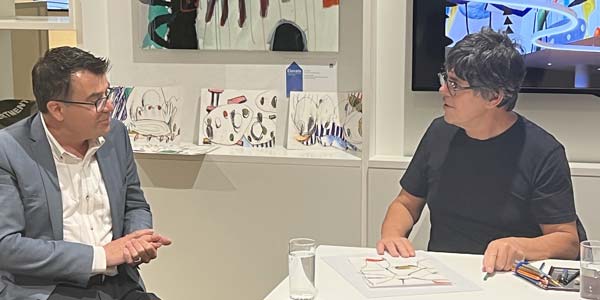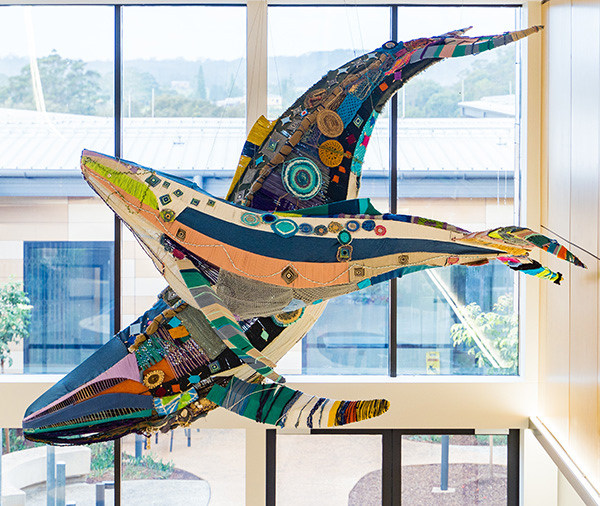The start of 2023 has been an exciting time of reflection, celebration and positive change. Dr Jean-Frédéric Levesque discusses emerging opportunities, and highlights how the arts is enhancing healthcare experiences for health staff and the community.
Over the last two months, our office in St Leonards has played host to the ‘Elevate’ art exhibition – a showcase of some of the arts offered at various health facilities across NSW, and a celebration of the positive impact the arts is having on NSW Health patients, staff and visitors.
Our staff have had the opportunity to be immersed in creative events, art displays and online arts experiences. The series has included a showcase of artistic talents among health staff; and the chance to share personal health stories through art. I had the pleasure of meeting artist-in-residence Peter Poulet, who joined the exhibition to create artworks inspired by the health stories shared by staff. This was a humbling experience that I was honoured to share with my colleagues.
The arts are an important element of patient, staff and visitor experience across health facilities. The exhibition is an initiative of the NSW Health and the Arts Framework, led by Health Infrastructure in partnership with the Ministry of Health, local health districts, networks, pillars and health organisations, artists as well as art and community organisations.

Realising the clinical benefits
Exposure to the arts has a profoundly beneficial impact, improving health and wellbeing through enhancing the design and delivery of health services, and the accessibility and influence of health promotion, health literacy and public health messaging.
I am passionate about the arts and its therapeutic benefits. I play classical guitar, which enables me to express myself and have a creative outlet that contributes to my wellbeing. I have also seen the therapeutic benefits of the arts in the clinical setting.
The NSW Health Arts Advisory Panel, of which I have been a member for four years, helps to drive the implementation of the Arts Framework and provide advice on integrating the arts into the design and delivery of health services and messaging. The panel is led by Rebecca Wark, Chief Executive of Health Infrastructure, who shares more about this in our guest editorial.
The clinical benefits of the arts have been recognised for some time. Art in all its forms is already being used across various clinical areas, including cancer treatment centres, mental healthcare, aged care, and in the care of children and young people. It has been proven to reduce stress and anxiety during an often challenging time for people.
We need to consider the role of the arts in healthcare delivery, as much as any other medical intervention. We have an opportunity to embrace the incredible artistic talents that exist within NSW Health and empower staff to bring their passion and talents to work, which can help to build arts literacy across the sector.
The ACI’s Innovation Exchange is one key enabler for NSW health services and staff to share successful projects that have improved clinical care through the arts. Read our feature story on the new-look Innovation Exchange for more information.
Rebecca Wark provides some fantastic examples of arts in health in her editorial, describing how art installations can help a local community feel more comfortable and connected within their health service.

We also know that improving cultural competency among health staff and health outcomes for Aboriginal communities involves creating spaces and experiences that represent and recognise the traditional owners of our lands. The ACI has focused on this in the development and implementation of our My rehab, my journey – Gadjigadji resource, which aims to improve the experience for Aboriginal people in the rehabilitation environment. You can read more about this in our feature story, which highlights how local services are using the arts to provide a culturally safe space for patients.
Embracing new opportunities
In January, we launched our new Strategy which outlines the ACI’s bold strategic focus areas for the next three years. It highlights how we will work with you to foster and enable clinical innovation across the health system to bring about changes that will improve patient experiences and outcomes. Our focus on enacting the strategy will involve re-balancing the work we do to prioritise projects that push forward transformational change.
This is even more timely as the ACI has become part of a new Clinical Innovation and Research Division within NSW Health, alongside the Office of Health and Medical Research (OHMR).
The new division provides a central point from which to drive a focus on statewide research and innovation priorities, offering valuable opportunities to create a more seamless integration from research to patient care. Both entities will continue to operate separately but will be overseen by myself as the newly appointed Deputy Secretary for Clinical Innovation and Research.
We have so many assets and talented people in NSW in this space. Bringing various teams together will enable us to get a more coordinated and impactful approach to innovation, that will ultimately improve healthcare delivery, experiences, and health outcomes.
A Focus on ACI, 2022
In February, we were proud to release A Focus on ACI 2022 – a digital snapshot of our achievements throughout 2022. This is a wonderful reflection of our people, progress and strong partnerships across NSW Health. I invite you to reflect on how we are all making a difference to healthcare through patient-centred, clinically led, evidence-based innovations.